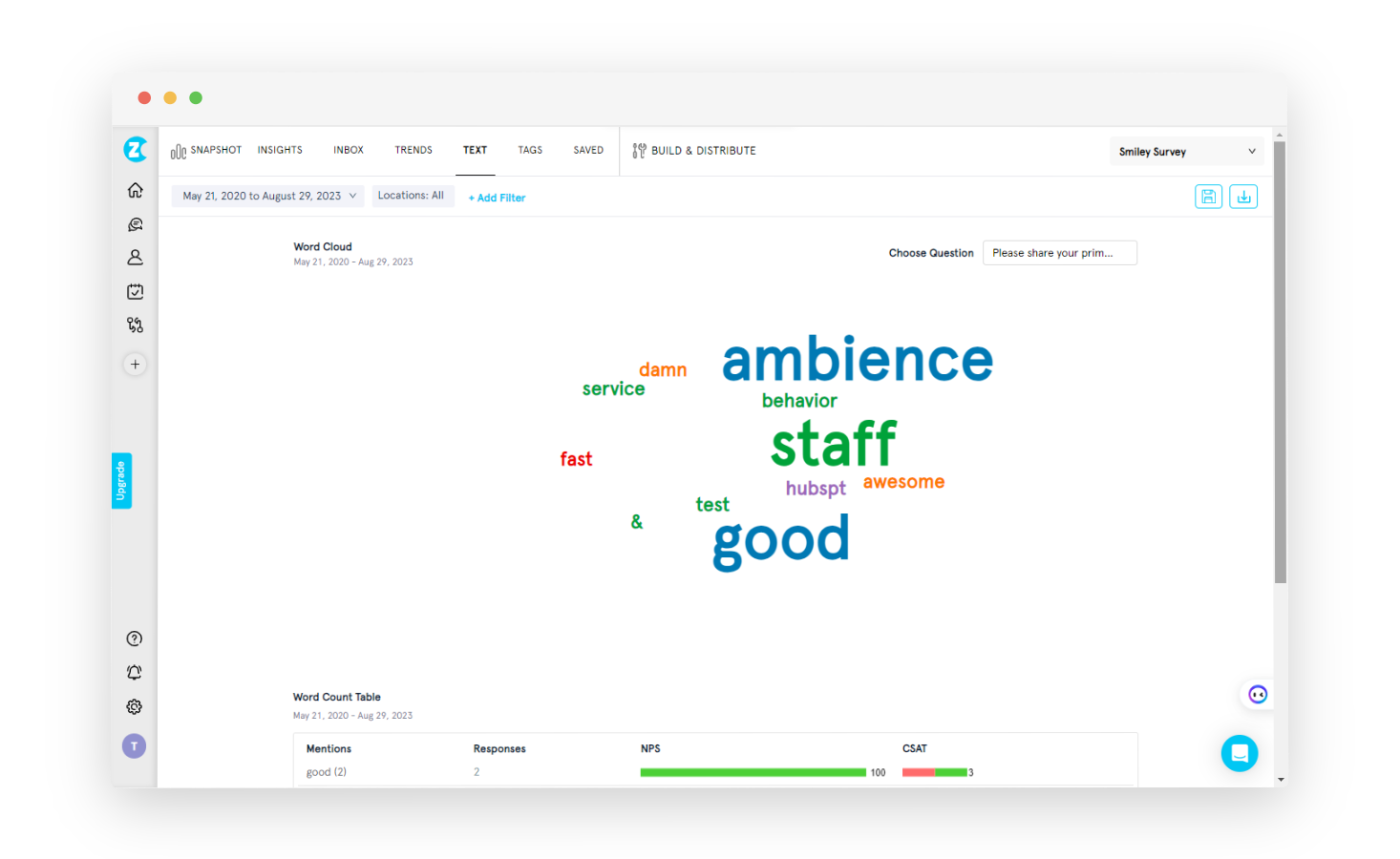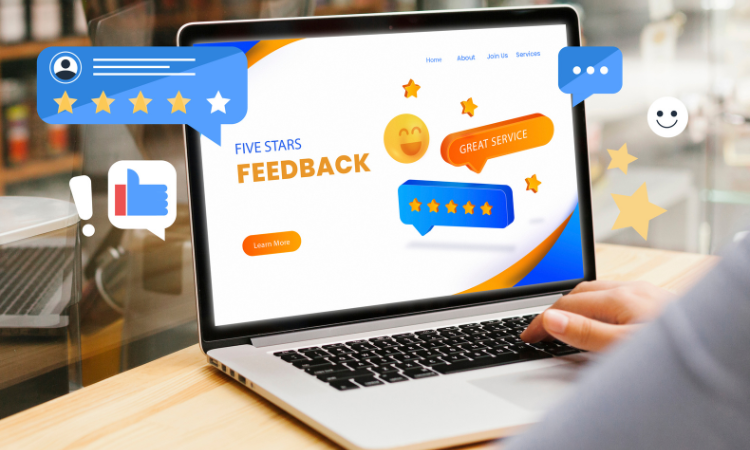Understanding the why behind what your customers do is one of the most powerful competitive advantages you can unlock — and that’s exactly what intent analysis is designed for.
Imagine someone searching for a ‘green silk dress’. The action seems simple — a quick search. But the intent behind it? That could vary:
- They might be ready to buy
- Comparing prices
- Looking for styling tips
- Researching for a fashion blog post
Each intent calls for a different next step. The same is true across every customer interaction you manage — from feedback forms and support chats to survey responses and behavior on your site. When you understand intent, you’re no longer just reacting to what customers say — you’re uncovering what they mean, what they need, and what they might do next.
That’s where intent analysis comes in. By analyzing the language, tone, and context behind each message or action, you can identify friction before it becomes churn, spot opportunities for upsell, support, or product improvement, and personalize communication based on what really matters to your customers.
In this guide, we'll explore how intent analysis works — and how you can use it to turn unstructured feedback into clear, confident decisions. So, let's get started!
TL;DR
- Intent analysis decodes the reason behind customer behavior, turning feedback, surveys, and interactions into insight that reveals pain points, hesitation, and opportunities.
- It goes beyond sentiment to detect purpose—whether it's frustration, praise, churn signals, or purchase intent, giving your teams context to act faster.
- To understand customer intent across touchpoints, you need to tune into not just what’s said, but when, where, and how. It reveals hidden friction across journeys in different industries.
- You should map existing customer feedback, analyze language and tone, group themes, and act on insights fast, especially at critical points in the customer journey to perform intent analysis.
- Focusing on high-risk signals, building shared intent labels, responding quickly, tracking themes over time, and using intent analysis tools can help you understand customers at a deeper level.
- Zonka Feedback's AI Feedback Intelligence takes intent analysis to the next level with smart summaries, thematic insights, automatic tagging, and scalable automation to help you act instantly and strategically. You can schedule a demo or sign up for a free trial to check out its current abilities.
Turn Customer Feedback into Actionable Insights
Use Intent Analysis to detect hidden signals, decode user intent, and act faster to reduce churn and improve customer experience.

What is Intent Analysis in Customer Experience?
At its core, intent analysis is the process of identifying the deeper motivations behind what your customers say or do. It goes beyond just tracking behavior — it helps you uncover the reason behind each action, comment, or piece of feedback.
When someone leaves a review, responds to a survey, or chats with your support team, they’re not just sharing words — they’re signaling an intent. That intent might be to express dissatisfaction, ask for help, make a suggestion, or praise something they appreciated.
💡Intent analysis is a crucial process for understanding the underlying reasons behind customer behaviors and leveraging this insight to create personalized customer experiences and targeted marketing strategies.
Think of intent analysis as a lens that lets you read between the lines. With the right text analysis tools, you can break down every comment to understand:
- Is this customer happy — or frustrated but polite?
- Are they asking a question — or raising an unspoken concern?
- Are they ready to buy — or still unsure?
This kind of insight allows you to respond in the moment, route feedback to the right teams, and make improvements based on what customers actually need — not just what they say.
And because much of this intent is hidden in unstructured text (open-ended questions responses, support messages, review comments), modern AI-powered intent analysis can help you scale this understanding across thousands of touchpoints, in real-time.
Understanding Customer Intent Across Touchpoints
Intent isn’t always obvious. Most of the time, it shows up in the quiet cues — a comment that sounds polite but hides frustration, a feedback note that feels neutral but carries urgency. You’ve probably seen it yourself:
- Someone browses the same product page three times but never clicks “Buy”
- A feedback form says “Loved the consultation, but had to wait too long”
- A customer asks about eligibility or repayment terms, then goes silent
These aren’t just interactions — they’re signals. But interpreting them correctly means tuning into more than just the words. It depends on:
- Where the message comes from (Was it part of a support ticket? A post-purchase survey?)
- How it’s said (Was the tone curious, annoyed, uncertain?)
- When it happens (Is this early interest? A mid-journey hesitation? A last-step dropout?)
Let’s break that down a little further:
- In retail, a message like “The product’s great, but checkout was confusing” could mean the customer’s happy — but unlikely to come back unless something changes.
- In healthcare, someone leaving a comment like “I didn’t know how to reschedule my appointment” may not just be asking for help — they may be at risk of not returning at all.
- In financial services, when a customer says “I couldn’t understand the loan breakdown”, the intent may not just be confusion — it might be hesitation, fear, or distrust.
When you can recognize these moments for what they are — signals of intent — you move from simply collecting data to actually understanding your customers in context. And once you understand intent, you can step in at the right time, in the right way — whether that means clarifying, supporting, upselling, or just listening better.
Types of Customer Intent in CX Feedback
To act meaningfully on customer feedback, you first need to understand the kind of intent behind it. Is someone raising a concern? Asking for help? Exploring a feature? Each type of intent demands a different kind of response — and recognizing that early can make all the difference.

Here are some of the most common intent signals you’ll encounter in customer feedback:
- Complaint: Signals dissatisfaction or a broken experience. For instance, when someone mentions “The app kept crashing during checkout.”
- Suggestion: Proposes an improvement, feature, or better way to do something. For instance, an in-app survey response reads “It would be great if the app supported dark mode.”
- Churn Risk: Often subtle — may show up as disinterest, friction, or quiet frustration. For instance, a customer feedback says, “I’m not sure it’s worth renewing next month.”
- Product Interest/Upsell Opportunity: Shows curiosity about premium features, add-ons, or upgrades. For instance, “Do you offer a plan with more automation options?”
- Question/Info-Seeking: Indicates the need for clarity or help at a decision point. For instance, “I couldn’t figure out how to edit my submission.”
Recognizing these types of intent helps you move from raw data to real action. You can prioritize feedback based on urgency, route insights to the right teams, and tailor communication to match what customers actually need.
How Intent Analysis Helps Understand Your Customers?
When customers leave feedback, send messages, or browse your platform, with intent analysis, you can go deeper to understand what’s actually driving behavior at different touchpoints across the customer journey. And that’s how you move from collecting data to actually driving outcomes — reducing churn, improving conversions, and resolving hidden CX gaps.
Let’s look at how this plays out in real-world scenarios across industries.
1. Retail: Decoding Drop-Off and Improving Purchase Flow
Your website is full of signals. A customer searches for a “large, brown leather tote bag,” clicks on a product, scrolls, maybe adds it to cart… and then leaves. On its own, that behavior feels inconclusive. But when a post-exit survey says: “I loved the design but wasn’t sure it would fit my laptop.” That’s intent — and a missed conversion if you don’t act on it.
Here’s how intent analysis helps at retail touchpoints:
- At the Product Page: Spot hesitations about specs (e.g. unclear size)
- At the Checkout: Catch concerns like “It took too long to load” or “Promo code didn’t work”
- Cart Abandonment: Often signals last-minute hesitation
- At Post-Purchase Feedback: Understand why customers may not come back, even if the product is great
When you track these signals, you can:
- Update product content (better images, sizing info)
- Simplify cart flows
- Trigger support chats at the right moment
- Identify recurring friction points across journeys and devices
2. Healthcare: Uncovering Hidden Operational Gaps
Patients might not always say outright what went wrong — especially if they liked the care. You’ll often see feedback like: “The doctor was fantastic, but I had to call twice to reschedule.”
That’s not just a small inconvenience. It’s a signal of system-level friction, and if it keeps happening, it can affect follow-ups, retention, and even patient trust. Intent analysis helps you catch friction at healthcare touchpoints like:
- Appointment Scheduling Portals: Delays or unclear flows
- Follow-up Communication: Missed reminders, duplicate messages
- In-clinic Check-in: Long waits, unclear instructions
- Billing and Payments: Confusion about insurance or charges
From there, you can:
- Fix administrative processes
- Reduce wait anxiety with better updates
- Ensure post-care clarity (especially after diagnostics or procedures)
- Lower missed appointments and increase loyalty
3. Finance: Fixing Confusion Before It Becomes Lost Revenue
Financial products are complex, and many customers won't complain — they’ll just disappear. You might see a comment like: “I wasn’t sure if I qualified — the terms were confusing.” That’s a churn signal in disguise.
Common Finance touchpoints where intent matters include:
- Product Exploration: Visiting a loan, credit card, or insurance page
- Application Start/Stop points: Where users abandon mid-process
- Document Submission: Often where technical or emotional drop-off occurs
- Application Status Tracking: Anxiety around unclear timelines or next steps
With intent analysis, you can:
- Clarify eligibility and simplify language
- Offer human or AI support before abandonment
- Flag recurring friction in application flows
- Build more transparent, reassuring communication
It’s not just about one comment — it’s about catching the pattern before the revenue disappears.
From Comments to Patterns: Seeing What Customers Can’t Always Say
Single pieces of feedback are useful — but real power comes when intent themes repeat across touchpoints and segments. Let’s say:
- 12% of customers in one region say “checkout was too slow”
- New users frequently ask about plan inclusions
- Loyal customers start requesting features you don’t offer yet
Now you're not just reacting to individual voices — you’re tracking intent patterns over time and locations. That lets you fix process issues that are tied to churn, prioritize improvements with the biggest business impact, and tailor communication by region, segment, or lifecycle stage.
Advanced Techniques in Intent Analysis
With the advancements in technology, intent analysis has evolved to incorporate sophisticated techniques such as machine learning, AI, and semantic analysis. These techniques can provide deeper insights into customer behavior and help predict customer intent.
Let’s explore each of these in the following subsections.
a. Machine Learning and AI in Intent Prediction
Machine learning and AI have revolutionized the field of intent analysis. Analyzing customer behavior, these technologies can forecast customer intentions, furnishing businesses with valuable insights to enhance their marketing strategies.
For instance, machine learning algorithms can predict purchase intentions by scrutinizing customer behavior to identify potential product interests. Similarly, AI can convert raw data into actionable insights using algorithms and computational models.
These insights can guide businesses in tailoring their offerings to meet customer needs, thereby improving customer satisfaction and boosting conversion rates.
b. Semantic Analysis for Deeper Insights
Semantic analysis is another advanced technique used in intent analysis. It involves extracting meaning from textual content, enabling computers to comprehend and interpret sentences, paragraphs, and other textual forms to discern the underlying intention.
For instance, a customer might leave a comment saying, “I love the product, but the delivery took too long”. While the sentiment is mixed, the intent is clear - the customer is likely to purchase again if the delivery time is improved.
Semantic analysis helps businesses understand these nuances, providing deeper insights into customer intent and helping them address specific pain points effectively.
How can you Perform Intent Analysis to Uncover Insights from Feedback?
If you’re already collecting feedback — through surveys, support channels, chats, or review sites — you’ve got the raw material. But feedback alone isn’t the goal. The real win is turning that data into insightful, actionable signals — and that’s exactly what intent analysis helps you do.
Let’s walk through what that looks like in practice.
1. Collect Feedback From Key Touchpoints
Intent shows up everywhere your customers interact with you— not just in surveys. It might appear in a support ticket where a customer says, “Still waiting to hear back about my claim.” Or in a post-visit form saying, “The nurse was great, but I didn’t get a reminder about my test results.” Or maybe it’s a customer leaving a product review: “Great shoes, but the sizing confused me.”
Across Retail, Healthcare, and Financial Services, these kinds of open-ended responses surface at high-impact moments like:
- Booking or scheduling interactions
- Product selection and comparison
- Transaction and checkout stages
- Billing or account setup
- Post-service follow-ups
So, start by mapping where your feedback is coming from, and align it to which part of the journey it reflects. Are people frustrated before the purchase? During onboarding? After service delivery? This context matters when interpreting their intent.
2. Analyze What’s Being Said — and Why
Once you have the data, it’s time to dive into the nuance. You’re not just reading the words — you’re interpreting tone, urgency, and what’s implied but not stated. The sentiment and context of the feedback can be easily analyzed through AI feedback analysis.
A comment like “I’m still waiting for someone to get back to me” might signal more than a delay — it could be early signs of churn or loss of trust. Intent analysis here means:
- Identifying emotion (frustration, excitement, confusion)
- Understanding tone (urgent, casual, indifferent)
- Recognizing purpose (complaint, praise, request, hesitation)

In healthcare, for example, a patient saying “I couldn’t understand the discharge summary” isn’t just confused — they’re likely feeling anxious, unsupported, and at risk of a poor outcome. In retail, “I love the design, but checkout took forever” indicates high purchase intent with a point of friction that could lose you the sale while in finance, “The process felt unclear” during application likely reflects distrust or hesitation — both of which kill conversions silently if left unaddressed.
3. Group Intents by Theme and Touchpoint
Next, begin grouping similar pieces of feedback to identify patterns. Maybe customers at one bank branch repeatedly mention issues with ID verification. Or patients across a specific clinic location keep saying it’s hard to reschedule appointments. Or new customers keep asking the same set of sizing questions during online checkout.
By organizing intent by theme (e.g., pricing, product understanding, wait times) and by touchpoint, you get clarity on what’s truly impacting experience — not just who said what.
This is where manual review starts to hit a wall — and where you’ll eventually want to bring in thematic analysis tools that can help you tag, filter, and surface these themes at scale.
Step 4: Translate Insights Into Actionable Plays
Once you’ve surfaced intent themes, the real value lies in what you do next. Here’s what that might look like:
- If you consistently see questions about eligibility or next steps in your onboarding, simplify your messaging or add better guidance in your application flow.
- If retail customers frequently mention slow delivery times, you can flag logistics or update expectations in your product pages.
- If patients express confusion over how to get lab results, that may prompt a process update or a communication tweak from your clinical operations team.
Each of these is a playbook item — a way to turn vague complaints or scattered praise into targeted CX improvements. Here are some commonly seen intents behind customer feedback especially useful for the retail industry and how you can take action.
1. Intent: Praise "This jacket is fantastic! The quality is amazing, and it fits perfectly. I'll definitely be recommending your brand to my friends."
Action: You can:
- Publicly acknowledge the positive feedback (e.g., respond to the review, share it on social media).
- Offer the customer a discount or loyalty program incentive.
- Use the feedback as a testimonial on their website or marketing materials.
2. Intent: Complaint "The delivery was very slow. It took over a week for my order to arrive."
Action: You can:
- Issue an apology and offer a solution, such as expedited shipping on future orders.
- Investigate the cause of the slow delivery and implement corrective measures.
- Provide clear communication regarding shipping times on the website.
3. Intent: Suggestion "The website could be improved by adding a live chat feature for customer support."
Action: You can:
- Implement a live chat feature on the website to address customer inquiries promptly.
- Acknowledge the suggestion and explain any potential challenges or timelines for implementation
4. Intent: Question "I'm not sure which size to order. Can you provide a size guide?"
Action: You can:
- Develop a comprehensive size guide with detailed measurements and recommendations.
- Offer a customer service representative to answer sizing questions through chat or phone.
5. Intent: Confusion "The return policy is very confusing. It's difficult to understand what items are eligible for return."
Action: You can:
- Simplify the return policy and clearly outline the terms and conditions on the website.
- Offer a dedicated FAQ section addressing common return-related questions.
Step 5: Close the Feedback Loop
Finally, don’t stop at understanding. Follow through. If someone shares frustration, reach out. If they suggest something useful, acknowledge it. If your analysis shows an issue is system-wide, fix it — and let customers know you did.
That last piece — letting customers know you listened — builds trust. And for high-churn industries like retail and finance, or high-sensitivity fields like healthcare, that trust is the difference between retention and loss, so you must always close the feedback loop to make that difference.
Best Practices to Implement Intent Analysis
Intent analysis is powerful — but only when it’s implemented with focus and clarity. Whether you’re just starting or trying to level-up your voice of customer program, these best practices will help you build an intent-driven CX engine that actually moves the needle.
- Start With the Feedback You Already Have: Start by mapping the feedback you already collect across touchpoints like checkout, onboarding, and service follow-ups. Label them by journey stage, not channel. Understanding where intent surfaces helps you interpret it more accurately and take meaningful action.
- Prioritize Feedback That Signals Risk or Opportunity: Focus first on high-impact signals — like objections, churn risks, or upsell interest. These carry business consequences. Low-friction praise or feature ideas matter, but risk-based and revenue-driving intents should be addressed faster. Prioritization avoids feedback fatigue and makes the intent analysis process scalable.
- Look for Patterns, Not Isolated Comments: One complaint is an opinion. Ten similar complaints is a pattern. Use tagging or classification to group recurring intents by location, product, or customer type. This turns scattered comments into clear themes — revealing systemic CX gaps or missed opportunities. Patterns give you confidence in where to invest your focus.
- Align Intent Categories Across Teams: Intent analysis only works when teams speak the same language. Define a consistent set of intent types — like “complaint,” “suggestion,” “hesitation,” “upgrade-ready” — and use them across support, product, and marketing. Shared classification avoids silos, ensures consistent routing, and helps everyone act faster on customer needs.
- Act While Intent Is Still Relevant: Customer intent has a short shelf life. If someone shares confusion, praise, or frustration, act on it quickly. A follow-up delayed by days can turn a potential advocate into a detractor. Build processes to detect and route critical intent fast—especially at high-friction or high-churn moments in the journey.
- Build Feedback Loops That Drive Change: Intent analysis only adds value if it closes the loop. Surface the insight, route it, act on it, and let the customer know. Use workflows or owner-based triggers to make sure intent doesn’t fall through cracks. Visibility into follow-through builds trust, strengthens loyalty, and justifies collecting feedback in the first place.
- Use an Intent Analysis Tool for High Volume: As feedback volume grows, manual tracking breaks down. When teams are slow to tag, prioritize, or connect feedback across locations—it’s time to scale. Use survey analysis software that automate intent detection, trend analysis, and routing. This ensures insights stay real-time and actionable, even as your customer base grows.
How Zonka Feedback Powers Intent-Led Customer Experience
When feedback floods in across locations, channels, and teams—acting on it shouldn't feel like chasing smoke. Zonka Feedback is a powerful customer experience tool that helps you turn raw, unstructured customer signals into prioritized, actionable insights — and does it in real time.
- AI-Powered Intent Detection and Classification: Instead of reading every comment, Zonka's AI Feedback Intelligence platform identifies what your customer really meant. Whether it’s a complaint hidden in polite language or interest masked by a question, AI tags feedback with intents like “Confusion,” “Churn Risk,” or “Feature Request” — helping your team prioritize quickly.
- Smart Summaries that Highlight What Matters: Reading through every open-ended response isn't scalable. Its AI Smart Summaries break down each feedback entry into a quick, digestible summary that captures core sentiment and intent. Teams can scan summaries, understand context fast, and act where it counts.
- Sentiment + Intent Reports that Reveal Trends: Every feedback comment carries emotion and direction. Zonka Feedback's dashboards visualize how customer sentiment and intent shift across locations, segments, and time—so you don’t just know how people feel, but why. For instance, a financial services team sees sentiment declining for “card activation.” The linked intent tag? “Unclear process.” That’s a fixable friction point—not just a bad mood.
- Unified Feedback Inbox with Tags and Themes: Zonka Feedback brings all your feedback—from surveys, reviews, chat logs, or call transcripts—into one centralized inbox. Every entry is automatically tagged by intent and theme, so teams aren’t digging through data. They’re scanning priorities.
- Workflow Automation Based on Detected Intent: Once the AI insights tool detects an intent, it can trigger workflows—automatically. Assign a support ticket, send a Slack alert, log a product request, or route an alert to leadership—all based on what the customer is really saying. For instance, when a customer says, “I might switch providers,” the feedback is tagged as churn risk and instantly escalated to retention with a predefined follow-up workflow.
- Multi-Location and Segment-Specific Insights: If you operate across branches or serve different customer tiers, Zonka Feedback helps you slice intent data by location, segment, or journey stage. This means you’re not just seeing global trends — you’re fixing issues exactly where they’re happening.
- Custom AI Models for Brand-Specific Insights: Your customers speak in your brand’s language—and Zonka's AI Feedback Intelligence learns it. With custom AI models, you can train the platform to recognize intent patterns unique to your products, services, or processes. For instance, if customer says, “Didn’t get my OTP to activate the account,” instead of tagging it as a generic support query, a custom model can learn that this signals onboarding drop-off — helping you flag it as conversion risk and act faster.
Conclusion
Customer feedback is everywhere but understanding what it really means is what separates reactive businesses from intent-driven ones. When you uncover the motivations behind every review, survey comment, or support message, you stop playing catch-up and start building experiences that truly resonate.
Whether it’s a shopper hesitating at checkout, a patient struggling with appointment rescheduling, or a banking customer unsure of next steps, intent analysis gives you the “why” behind every interaction. And that “why” is what helps you reduce churn, convert better, and deliver faster, more relevant experiences.
Understanding intent is only half the equation, the real advantage comes when you can act on it instantly and at scale. That’s where a powerful survey tool like Zonka Feedback helps you close the loop with speed and clarity. With features like sentiment analysis and text analysis, it helps you extract emotion, detect intent, and uncover what customers are really saying across every touchpoint. And with the upcoming launch of AI Feedback Intelligence, you’ll be able to not only identify customer intent but connect it to the right teams, uncover root causes through thematic clustering, and surface proactive recommendations.
Start your 14-day free trial for Zonka Feedback's existing CX suite or get early access to the upcoming AI capabilities and turn customer feedback into your competitive edge!
Frequently Asked Questions
1. What is Intention Analysis?
Intention analysis is the process of determining the underlying intention behind any text or user-generated content in social networks.
2. What is an example of intent Analysis?
You manage a clothing store and receive the following customer feedback: "The dress was beautiful, but it arrived wrinkled and took forever to ship."
Any basic analysis would suggest that the feedback points to a negative buyer intent, mentioning both product quality (beautiful) and delivery issues (wrinkled, slow).
However, intent analysis would help identify emotions like the use of "beautiful" suggests positive sentiment towards the dress itself. "Forever" and "wrinkled" imply frustration with delivery. At the same time, it also uncovers the customer intent- while dissatisfied with delivery, the customer clearly appreciates the dress. Their intent might be to:
- Highlight the delivery issue for improvement.
- Express overall satisfaction despite the inconvenience.
- Encourage others to buy the dress despite potential delivery challenges.
A powerful intent analysis software would also suggest actionable insights based on buyer intent like reaching out to the customer to apologize for the delivery issues and offer a solution (e.g., discount, faster shipping). Or, it could highlight faster shipping options on product pages.
3. What is intent analysis in NLP?
Intent analysis in NLP (Natural Language Processing) is the process of identifying the underlying purpose or goal behind a user’s text or message. It helps systems interpret whether the person intends to ask a question, give feedback, make a complaint, or take an action enabling smarter, contextual responses.
4. How does intent analysis help understand customer behavior?
Intent analysis helps businesses understand the motivations behind customer actions, enabling them to personalize experiences, enhance product development, and improve customer satisfaction. This allows for a deeper understanding of customer behavior and needs.
5. What is intent based sentiment analysis?
Intent-based sentiment analysis combines emotional tone detection with purpose interpretation. It not only identifies whether a message is positive, negative, or neutral but also uncovers why the sentiment exists — such as a complaint, suggestion, or churn signal. This layered insight helps businesses prioritize feedback and respond more effectively.




.jpg)
.jpg)
.jpg)

.jpg)
.jpg)

